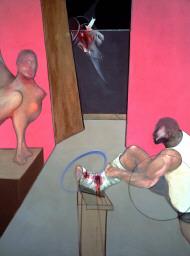Milan is paying tribute to the work of the troubled Anglo-Irish figurative painter Francis Bacon (1909-1992), whose powerful and often disturbing art won him widespread critical acclaim.
The city's Palazzo Reale is hosting a new exhibition with over 100 of his best works, most of them on show for the first time in Italy.
The exhibit, which counts loans from major museums around the globe, spans Bacon's lengthy artistic career, from his earliest, self-taught forays into art through to the dark pieces he finished shortly before he died. Rejected by his father for his homosexuality, Bacon left home at 16 and spent several months in Berlin and Paris. It was in the French capital that he discovered the works of Pablo Picasso, which moved him so deeply that he embarked on his own artistic career. On his return to London, in his early twenties, he started producing his first paintings. Despite his lack of any formal training, these works from the 1930s already display some of Bacon's hallmarks, such as his use of distorted figures, although his uncertain search for an artistic voice is also clear. The exhibit continues with Bacon's work from the post-war period, when he came to international attention with his Three Studies for Figures, considered one of his masterpieces, and his 'Heads' series.
Head VI was a particularly important piece, representing his first engagement with Diego Velasquez's Portrait of Pope Innocent X. Bacon considered the 1650 portrait one of the most important works in art history, and returned to it repeatedly in his own career. Best known of these reinterpretations is a series of three paintings entitled Studies After Velasquez.
Unfortunately only two of these survived Bacon's request they be destroyed, and both are on show in Milan, alongside a photograph of the lost third painting. The next section of the exhibit looks at several portraits of the artist's close friends. Of particular interest here are studies Bacon completed of another great 20th-century artist, Lucian Freud. The final part of the exhibit looks at the large-scale paintings of Bacon's later years, increasingly dark and twisted explorations of the human soul. The chaotic London studio used by Bacon from 1961 until 1992 is also brought to life in the exhibit, through a series of life-sized photos. Bacon, who died of a heart attack in Spain, bequeathed his estate to his lover John Edwards. Edwards donated the contents of the studio to a Dublin Gallery, which reconstructed it in its entirety as a final tribute to Bacon.
The Milan show, which runs until June 29, is a foretaste of a series of exhibits planned in major cities around the globe in 2009, marking 100 years since Bacon's death.








